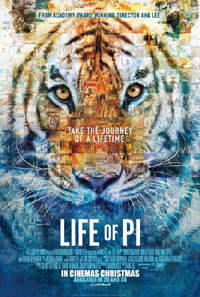 LIFE OF PI
LIFE OF PI(PG)
****1/2 (out of 5)
November 21, 2012
STARRING
Irrfan Khan as OLDER PI
Suraj Sharmas PI PATEL
Gerard Depardieu as FRENCHMAN
Rafe Spall as THE WRITER
Tabu as PI’S MOTHER
Adil Hussain as PI’S FATHER
Directed by: Ang Lee
BY KEVIN CARR
Listen to Kevin’s radio review…
Anyone who knows me as a critic knows that I don’t go wild over the award films. I’m not into the significant cinema that makes you think. In short, if it’s been a selection in Oprah’s book club, I’m leery of the film.
Case in point, while stuffy film critics had a collective orgasm over last year’s “Tree of Life,” I rolled my eyes and declared it one of the worst films of the year. The similarly polarizing “Melancholia” was better, though I wasn’t exactly a fan of that film.
This made my approach to “Life of Pi” a bit nerve-wracking. I had seen the trailers, and yes, they looked gorgeous. But I couldn’t tell what the movie was about. And having Ang Lee at the helm didn’t do much for me. His films have blown hot and cold in my opinion. While I enjoyed “Crouching Tiger, Hidden Dragon,” I was mostly bored with “Brokeback Mountain.” And don’t get me started on the hot mess that was “The Hulk.”
However, “Life of Pi’ is an entirely different animal. It’s not a traditional mainstream film. That doesn’t mean you can’t follow the story; it’s just hard to encapsulate. It also deals with greater, often spiritual, themes that are quite thought-provoking. On the surface, “Life of Pi” is a basic story, but deeper into the film, it’s got a lot to say.
The greatest evidence that it works on a greater level is that I haven’t been able to stop thinking about it after I saw it. That’s a real feat for a film to do, especially to me who sees so many films that they can often feel disposable.
Based on the best-selling novel, “Life of Pi” tells the story of a young Indian man named Pi (Suraj Sharmas) whose family owns a zoo in Southern India. After a rough financial time, the family decides to sell the animals overseas in Canada. However, during their voyage, the ship sinks, leaving Pi stranded on a lifeboat with a full-grown Bengal tiger. The bulk of the movie follows Pi’s dangerous relationship with the tiger and how they try to survive the journey.
Above all else, “Life of Pi” is a gorgeous looking film. Shot in 3D and utilizing some amazing visual effects, the film remains compelling in a situation that would be dull and mundane at the hands of another director. Like the films of Baz Luhrmann, “Life of Pi” was a visual spectacle I couldn’t take my eyes from.
Sure, it gets tedious at times in the midst of the ocean, but that’s part of the film’s point. The audience goes through a journey with Pi, all the while going through a turn of discovery. In the end, the audience emerges, along with Pi, with a greater understanding and greater questions about the world around them.
I had the unique experience to see this film with a friend of mine who grew up not 100 miles from where the beginning of the film took place. From the Indian perspective, he was quite critical of the film. Things that went unnoticed by me – from style and fashion to accents and vernacular – were things that really bothered him. So I suppose approaching this film from a strictly Indian perspective might not have the best results.
However, to a big, dumb American like myself, these many cultural problems were unimportant. Like Lee’s “Crouching Tiger, Hidden Dragon,” which I have heard some Chinese folks criticize for being unoriginal, “Life of Pi” was made for a wider audience. And I, for one, devoured it.
Podcast: Play in new window | Download
